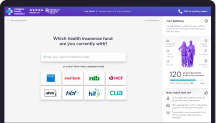The Australian government has three types of initiatives in place to encourage people to take out private health insurance. These can impact you financially in a number of ways, so let’s take a look at each in more detail.
1. The Private Health Insurance Rebate
The government’s Private Health Insurance Rebate helps you to afford private health cover by contributing a portion of money to your premiums. This is paid either by a refundable tax offset when you lodge your return or as a reduction in the cost of your premiums.
Introduced in 1999, the rebate originally allocated a 30% discount on health insurance premiums to everyone under 65 years of age. Those over 65 received a higher rebate.
Income testing and age tiers were introduced in 2012 which determine who’s eligible to receive the rebate. For example, if you’re single, under 65 and earning over $140,000, you won’t be eligible. However, if you’re a single person under 65 and earning $90,000 or less, you’re entitled to around a 25% rebate.
Couples and families are also included in the initiative and the rebate is calculated on the joint income of the parents and the age of the oldest person covered by the policy. For example, a married couple where the husband is over 65 and their joint income is less than $180,000 can expect a rebate of approximately 30%.
The three things you need to claim the Private Health Insurance Rebate are:
- Eligible for Medicare,
- Private health cover that complies and
- An income that falls beneath the threshold.
Work out your Private Health Insurance rebate here.
2. The Medicare Levy Surcharge
Anyone who earns over $27,069 will automatically pay a Medicare Levy on their income of 2%. This is a government tax that is used to fund the public healthcare system.
But the government has also added an extra tax for high earners who don’t have private health insurance. This is called the Medicare Levy Surcharge (MLS) and it increases based on your age and income. For example as a single you’ll pay:
- 1% of your taxable income if you earn over $90,000,
- 1.25% of your taxable income if you earn over $105,000, and
- 1.5% of your taxable income if you earn over $140,000 (maximum rate).
By taking out private health insurance with the right level of hospital cover you can avoid the Medicare Levy Surcharge.
You can find out more about the Medicare Levy Surcharge here.
3. Lifetime Health Cover loading
The Lifetime Health Cover loading (LHC) was introduced on 1 July 2000, to encourage young people to take out private health insurance for hospital cover. Like the Medicare Levy Surcharge it’s designed to ease pressure on the public system.
The LHC is not strictly a tax but a 2% loading that gets added onto your insurance premium every year after your 31st birthday. It basically penalises those who take out health insurance later in life. For example, if you decide to take out health insurance when you’re 40 you’ll pay an extra 20% on your premium.
The longer you wait to take out health insurance the more you’ll pay until you purchase it. The maximum loading that you could incur is capped at 70%. However, once you’ve held private health insurance for 10 continuous years the LHC will be automatically removed.
You can find out more about the Lifetime Health Cover loading here.





